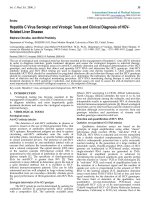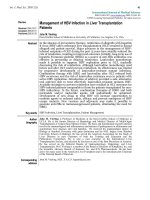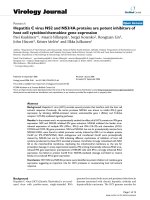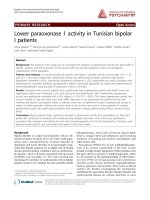Báo cáo y học: " Hepatitis C virus infection in Brazilian long-distance truck drivers" pptx
Bạn đang xem bản rút gọn của tài liệu. Xem và tải ngay bản đầy đủ của tài liệu tại đây (527.63 KB, 6 trang )
SHOR T REPOR T Open Access
Hepatitis C virus infection in Brazilian
long-distance truck drivers
Nara R Freitas
1,2
, Sheila A Teles
2
, Marcos A Matos
2
, Carmen LR Lopes
2
, Nádia RS Reis
1
, Márcia P Espírito-Santo
3
,
Elisabeth Lampe
3
, Regina MB Martins
1*
Abstract
Hepatitis C virus (HCV) infection is a global public health problem. Long-distance truck drivers live apart from their
family for long periods of time, a lifestyle that favors at-ri sk behaviors such as unprotected sex with multiple part-
ners and illicit drug use. As data concerning HCV infection in this population are still rare, this paper aims to inves-
tigate the prevalence, genotypes/subtypes, and the factors associated with HCV infection in long-distance truck
drivers in Brazil. A cross-sectional survey was carried out with 641 Brazilian long-truck drivers who were recruited at
a major truck stop located at kilometer 1,296 of the BR-153 highway, which is considered to be one of the longest
roads in Brazil. All individuals were interviewed, and their serum samples were tested for the presence of antibo-
dies to HCV (anti-HCV) by ELISA and immunoblot. Anti-HCV positive samples were tested for HCV RNA by PCR
amplification of the 5′ NC and NS5B regions and were genotyped using the LiPA assay and nucleotide sequencing,
respectively. Factors associated with HCV infection were identified with logistic regression. The prevalence of HCV
infection was 1.4% (95% CI: 0.7-2.8). History of blood transfusion, sharing of personal hygiene tools, illicit drug use
and HBV status were factors independently associated with HCV infection in the study population. HCV RNA was
detected in 8/9 anti-HCV positive samples, in which genotypes 1 (n = 3), 2 (n = 2), and 3 (n = 3) were determined
by LiPA. Using phylogenetic tree analysis of the NS5B region, subtypes 1a (n = 1), 1b (n = 2), 2b (n = 2) and 3a
(n = 3) were identified. These data show that the prevalence of HCV infection among Brazilian truck drivers was
similar to that observed for the general population. History of blood transfusion, sharing of personal hygiene tools,
illicit drug use and HBV status were predictors of HCV infection. The HCV genotypes/subtypes identified in the
study population are consistent with those circulating in Brazil.
Findings
Hepatitis C virus (HCV) infectio n is a global public
health problem. Approximately 130-170 million indivi-
duals are thought to be infected worldwide [1]. On aver-
age, 80% of acutely infected individuals develop a
chronic infection. The principal long-term complications
of chronic hepatitis C are cirrhosis and hepatocellular
carcinoma [2]. H CV is characterized by a high degree of
genetic heterogeneity. Phylogenetic analysis of full-
length or partial sequences of HCV isolates has led to
the identification of six ge notypes (1 to 6), each com-
prising multiple subtypes (designated a, b, c, etc) [3].
These genotypes and subtypes have distinct geographical
distributions, and information on their distribution is
needed to perform effective molecular and epidemiologi-
cal HCV surveillance [4,5].
Long-distance truck drivers live apart from their
family for long periods of time, a lifestyle that favors at-
risk behaviors such as unprotected sex with multiple
partners, including commercial sex workers, and illicit
drug use, which have been demonstrated to be predic-
tors of HCV, hepatitis B virus (HBV), and human
immunodeficiency virus (HIV) infections [6-9]. In spite
of these risk factors, there have been few investigations
onHCVinfectioninthispopulation[9-12].Inapre-
viousstudy,anoverallHBVinfectionprevalenceof
18.9% was found among long-distance truck drivers in
Brazil. Length of profession longer than 20 years, time
away from home lasting more than 15 days and a his-
tory of sexual transmitted infections (STIs) were asso-
ciated with HBV infection [13]. However, no data are
available on HCV infection in this highly mobile
* Correspondence:
1
Instituto de Patologia Tropical e Saúde Pública, Universidade Federal de
Goiás (UFG), Goiás, Brazil
Full list of author information is available at the end of the article
Freitas et al. Virology Journal 2010, 7:205
/>© 2010 Freitas et al; licensee BioMed Central Ltd. This is an Open Access article distributed under the terms of the Creative Commons
Attribution License ( es/by/2.0), w hich permits unrestricted use, distribution, and reproduction in
any medium, provided the original work is prope rly cited.
population in Brazil and more generally in Latin Amer-
ica. Thus, the aim of the present study was to investi-
gate the prevalence, genotypes/subtypes, and the factors
associated with HCV infection in long-distance truck
drivers in Brazil.
A cross-sectional study was carried out in a popula-
tion of long-distance truck drivers in Brazil that had
been previously examined for HBV epidemiological sta-
tus [13]. From October 2005 to October 2006, truck dri-
vers were recruited once per month (on a Satur day or a
Monday, during the morning or afternoon) at a major
truck stop located at kilometer 1,296 of the BR-153
highway in Goiânia City, Central Brazil. This highway is
considered to be one of the longest roads in Brazil
(3,566.3 km), spanning the country from south to north
(Figure 1). A total of 771 long-distance truck drivers
from different regions of Brazil who stopped to refuel,
eat and rest at this stop were invited to take part in the
study. Of these, 641 agree d to participate, and informed
consent was obtained from all. There was no statistical
difference based on socio-demographic characteristics
between the participants a nd those who were unwilling
to participate (data not s hown). The protocol used i n
the present study was approved by the Ethical Commit-
tee of the Materno Infantil Hospital in Goiânia city,
Goiás state. The participa nts were interviewed to collect
socio-demographic data and possible risk factors for
HCV infection. Blood samples were collected f rom all
participants, and sera were stored at -20°C.
All serum samples were tested using an enzyme-linked
immunosorbent assay (ELISA) for the presence of anti-
bodies to HCV (anti-HCV) (Hepanostika Ultra, Biome-
dical, Shanghai, China). Anti-HCV-positive samples
were retested by an immunoblot (Bioblot HCV, Biokit,
Barcelona, Spain) and submitted to RNA detection by a
nested PCR with primers complementary to the con-
served area of the 5′ NC region of HCV [14]. A line
probeassay(Inno-LiPAHCVII, Innogenetics, Ghent,
Belgium) was used to determine the genotype of the iso-
lates using amplicons of the 5′ NC region. Nucleotide
sequence analysis was performed after a semi-nested
PCR amplification of the NS5B region [15].
Prevalence and 95% confidence intervals (95% CI)
were calculated. Fisher’s exact test was used to evaluate
association between variables and HCV infection
(defined as positive f or anti-HCV). These, estimated by
the odds ra tio in univariate analysis, we re further ana-
lyzed with a stepwise logistic regression model. Statisti-
cal significance was assessed at the 0.05 probabili ty level
in all analyses. Statistical e valuations were performed
using SPSS, version 11.0 (SPSS Inc., Chicago, US, 1999).
The study group of 641 Brazilian long-distance truck
drivers was composed mainly of males (99.2%). The
mean age was 40.6 ± 10.1 years. The majority of the
participants were white (69.9%), married (77%), had
received eight years or less of formal education (funda-
mental education in Brazil) (68.8%) and were truck dri-
vers for more than 10 years (62.6%). More than half of
the group (51.9%) reported a monthly income of US$
750 or less. Ten truck drivers were found to be anti-
HCVpositivebyELISA.Ofthese,nineweresubse-
quently confirmed as positive by immunoblot, resulting
in an anti-HCV prevalence of 1.4% (95% CI: 0.7-2.8).
Table 1 presents the univariate and multivariate ana-
lyses of the factors associated with HCV infection in
long-distance truck drivers in Brazil. In the univariate
analysis, sharing of personal hygiene tools, illicit drug
use and HBV status were predictors of HCV infection
and history of blood transfusion showed an association
with a borderline P value. These factors were indepen-
dent associated with HCV infection in a multivariate
analysis.
Among the anti-HCV-positive samples, eight were
HCV RNA positive. The LiPA assay for the 5′ NC
region was able to determine the following genotypes: 1
(n = 3), 2 (n = 2), and 3 (n = 3). For subtyping analysis,
all eight HCV RNA-positive samples could be amplified
and sequenced in the NS5B region. Using phylogenetic
tree analysis of the NS5B region (Figure 2), subtypes 1a
(n = 1), 1b (n = 2), 2b (n = 2) and 3a (n = 3) were
identified.
The present study represents the first report on the
epidemiology of HCV infection in long-distance truck
drivers in Brazil. The prevalence of HCV infection
found was similar to that observed for the general popu-
lation (1.42%-1.5%) [16,17]. Regarding data for truck dri-
vers in other countries, the prevalence determined in
Figure 1 Localization of the BR-153 highway in Brazil.
Freitas et al. Virology Journal 2010, 7:205
/>Page 2 of 6
Table 1 Factors associated with HCV infection in Brazilian long-distance truck drivers
HCV OR
b
OR
adjusted
d
Variables Pos/Total
a
(%) (95% CI)
c
P (95% CI) P
Age
≤ 40 years 3/330 (0.9) 1.0
> 40 years 6/306 (2.0) 2.2 (0.5-8.8) 0.32
Duration of profession
≤ 10 years 1/236 (0.4) 1.0
11-20 years 5/200 (2.5) 6.0 (0.7-137.4) 0.10
> 20 years 3/200 (1.5) 3.6 (0.3-90.0) 0.34
Days away from home
≤ 15 1/124 (0.8) 1.0
> 15 8/512 (1.6) 1.9 (0.2-15.7) 1.00
Blood transfusion
No 6/560 (1.1) 1.0 1.0
Yes 3/62 (4.8) 4.7 (1.1-19.2) 0.05 6.4 (1.3-32.3) 0.02
Sharing of personal hygiene tools
No 5/543 (0.9) 1.0 1.0
Yes 4/87 (4.6) 5.2 (1.4-19.7) 0.03 5.0 (1.1-22.3) 0.03
Illicit drug use
No 5/527 (0.9) 1.0 1.0
Yes 4/81 (4.9) 5.4 (1.4-20.6) 0.02 6.8 (1.4-32.0) 0.01
Tattoo/piercing
No 8/582 (1.4) 1.0
Yes 1/54 (1.9) 1.3 (0.2-11.0) 0.55
Incarceration
No 9/577 (1.6)
Yes 0/57 (0.0) - 1.00
Sex with drug user
No 6/410 (1.5) 1.0
Yes 1/61 (1.6) 1.1 (0.1-9.5) 1.00
Sex with a sex worker
No 4/287 (1.4) 1.0
Yes 5/349 (1.4) 1.0 (0.3-3.8) 1.00
Sex with man
No 6/616 (1.5)
Yes 0/20 (0.0) - 1.00
Condon use during the last sexual intercourse
Yes 4/307 (1.3) 1.0
No 5/320 (1.6) 1.2 (0.3-4.5) 1.00
Sexually transmitted infections
No 5/396 (1.3) 1.0
Yes 3/219 (1.4) 1.1 (0.3-4.6) 1.00
Number of sexual partner (last 6 months)
≤ 1 5/365 (1.4) 1.0
2-5 2/191 (1.0) 0.8 (0.1-4.5) 1.00
> 5 2/66 (3.0) 2.2 (0.3-13.4) 0.29
HBV status
Negative 4/519 (0.8) 1.0 1.0
Positive 5/117 (4.3) 5.8 (1.5-22.0) 0.01 5.0 (1.2-20.1) 0.02
a
The denominator represents the number of males who answered the question.
b
OR, odds ratio.
c
CI, confidence interval.
d
adjusted by age, blood transfusion, sharing of personal hygiene tools, illicit drug use and HBV status.
Freitas et al. Virology Journal 2010, 7:205
/>Page 3 of 6
Figure 2 Phylogenetic tree analysis of the NS5B region (340 nt) of HCV isolates. The tree includes 8 sequences from truck drivers in Brazil,
12 reference sequences of genotypes 1 to 6, and 38 sequences from different regions of Brazil (initiated by BR): GO, Goiás state (Central), SP, São
Paulo and RJ, Rio de Janeiro states (Southeast) and RS, Rio Grande do Sul state (South). Strains belonging to this study are marked with a black
circle and reference sequences used were: 1a-m62321; 1b-m58335; 1c-d14853; 2a-d00944; 2b-d01221; 2c-d50409; 3a-d17763; 3b-d49374; 4a-
y11604; 5a-y13184; 6a-y12083 and 6b-d84262. Genotype and subtype are indicated for each branch. The bootstrap values > 75% are indicated at
the branches. The bar indicates genetic distance scale expressed as substitutions per 100 bases.
Freitas et al. Virology Journal 2010, 7:205
/>Page 4 of 6
this study was within the confidence interval range
reported for Bangladesh (0.8%; 95% CI: 0.2-2.4), India
(3.0%; 95% CI: 0.8-9.2), and Eritrea (6.0%; 95% CI: 1.5-
17.5) [10-12], but it was lower than that observed in
New Mexico, USA (8.5%; 95% CI: 6.5-11.0) [9].
Illicit drug use was the main predictor of HCV infec-
tion in the study population. Among the 8 1 truck dr i-
vers who reported illicit drug use, the majority had used
non-injecting drugs, including the anti-HCV-positive
individuals. The risk of HCV infection associated with
non-injecting drugs is probably linked to the usual prac-
tice of sharing of non-injecting drug implements, such
as pipes and straws, for smoking and sniffing/snorting
drugs, which could lead to blood-to-blood contact [18].
Additionally, one-third of truck drivers in the current
study reported regular use of amphetamines (“rebite”,an
oral stimulant), and most drivers also reported ongoing
alcohol consumption. These habits are frequent among
Brazilian truck drivers and appear to influence unsafe
sex practices [6-8].
In fact, risk behaviors such as unprotected sex with
multiple partners, including commercial sex workers,
and history of STIs were frequent among the truck dri-
vers investigated but were not associated with HCV
infection. These data are consistent with findings
obtained among truck drivers in New Mexico, USA [9].
Other variables related to percutaneous exposure to
blood such as history of blood transfusion, sharing of
personal hygiene tools, and HBV status were indepen-
dent associated with HCV infection in the study popula-
tion. Regarding blood transfusion, HCV infection was
associated with this procedure before the introduction
of screening for anti-HCV antibodies in Br azilian blood
banks [4]. In fac t, the anti-HCV-positive truck drivers
reported having undergone blood transfusions with
blood that had not been screened for anti-HCV antib o-
dies (before November 1993). Similarly, but in lower
level, the sharing of personal hyg iene tools has also
shownanassociationwithHCVinfection[19,20],as
well as HBV status [9].
Among the nine anti-HCV-positive truck drivers, all
but one were also HCV RNA positive, highlighting their
potential to transmit HCV. Further, these individuals
were infected with HCV genotypes 1, 2 and 3. These
genotypes were also detected in other populations in
Brazil, such as blood donors and chronically infected
patients. The HCV subtypes identified in the study
population (1a, 1b, 2b and 3a) are also consistent with
the subtypes circulating in Brazil [15,21-23].
These results must be considered in the context of the
study’s limitations. The study population does not repre-
sent all long-distance truck drivers in Brazil but only
those recruited at a large truck stop along the BR-153
highway in Central Brazil. Nonetheless, this is one of
the longest and most important roads in Brazil, span-
ning the country from south to north, where long-
distance truck drivers represe nt a highly mobile popula-
tion. Moreover, given that there is a lack of available
data on the serological and molecular epidemiology of
HCV infection among long-distance truck drivers in
Latin America, these data provide valuable insight into
this topic.
In summary, the prevalence of HCV infection was
similar to that observed for the general population. His-
tory of blood transfusion, sharing of personal hygiene
tools, illicit drug use and HBV status were predictors of
HCV inf ection. The HCV genotypes/subtypes identified
in the study population are consistent with those circu-
lating in Brazil.
Acknowledgements
Financial supports: CNPq (473938/2004-9). We thank to PDTIS-FIOCRUZ
Genomic Platform for performing the DNA sequencing.
Author details
1
Instituto de Patologia Tropical e Saúde Pública, Universidade Federal de
Goiás (UFG), Goiás, Brazil.
2
Faculdade de Enfermagem, UFG, Goiás, Brazil.
3
Instituto Oswaldo Cruz, Fundação Oswaldo Cruz, Rio de Janeiro, Brazil.
Authors’ contributions
NRF, SAT, MAM, RMBM contributed to study concept and design. SAT was
responsible for the statistical analysis. CLRL, NRSR, MPES, EL revised the
manuscript for intellectual content. All authors read and approved the final
version of the manuscript.
Competing interests
The authors declare that they have no competing interests.
Received: 11 June 2010 Accepted: 27 August 2010
Published: 27 August 2010
References
1. Lavanchy D: The global burden of hepatitis C. Liver Int 2009, 29:S74-S81.
2. Ghany MG: Diagnosis, management, and treatment of hepatitis C: An
update. Hepatology 2009, 49:1335-1374.
3. Simmonds P, Bukh J, Combet C, Deléage G, Enomoto N, Feinstone S,
Halfon P, Inchauspé G, Kuiken C, Maertens G, Mizokami M, Murphy DG,
Okamoto H, Pawlotsky JM, Penin F, Sablon E, Shin-I T, Stuyver LJ, Thiel HJ,
Viazov S, Weiner AJ, Widell A: Consensus proposals for a unified system
of nomenclature of hepatitis C virus genotypes. Hepatology 2005,
42:962-973.
4. Carneiro MAS, Teles SA, Lampe E, Espírito-Santo MP, Gouveia-Oliveira R,
Reis NRS, Martins RMB: Molecular and epidemiological study on
nosocomial transmission of HCV in hemodialysis patients in Brazil. JMed
Virol 2007, 79:1325-1333.
5. Oliveira Mde L, Bastos FI, Telles PR, Hacker Mde A, Oliveira SA, Miguel JC,
Yoshida CF: Epidemiological and genetic analyses of hepatitis C virus
transmission among young/short-and long-term injecting drug users
from Rio de Janeiro, Brazil. J Clin Virol 2009, 44:200-206.
6. Lacerda R, Gravato N, McFarland W, Rutherford G, Iskrant K, Stall R, Hearst N:
Truck drivers in Brazil: prevalence of HIV and other sexually transmitted
diseases, risk behavior and potential for spread of infection. AIDS 1997,
11:S15-S19.
7. Malta M, Bastos FI, Pereira-Koller EM, Cunha MD, Marques C, Strathdee SA:
A qualitative assessment of long distance truck drivers’ vulnerability to
HIV/AIDS in Itajaí, southern Brazil. AIDS Care 2006, 18:489-496.
8. Ferreira LO, de Oliveira ES, Raymond HF, Chen SY, McFarland W: Use of
time-location sampling for systematic behavioral surveillance of truck
drivers in Brazil. AIDS Behav 2008, 12:S32-S38.
Freitas et al. Virology Journal 2010, 7:205
/>Page 5 of 6
9. Valway S, Jenison S, Keller N, Vega-Hernandez J, Hubbard McCree D: Risk
assessment and screening for sexually transmitted infections, HIV, and
hepatitis virus among long-distance truck drivers in New Mexico, 2004-
2006. Am J Public Health 2009, 99:2063-2068.
10. Ghebrekidan H, Cox S, Wahren B, Grandien M: Prevalence of infection with
HIV, hepatitis B and C viruses, in four high risk groups in Eritrea. Clin
Diagn Virol 1998, 9:29-35.
11. Gibney L, Saquib N, Metzger J, Choudhury P, Siddiqui M, Hassan M: Human
immunodeficiency virus, hepatitis B, C and D in Bangladesh’s trucking
industry: prevalence and risk factors. Int J Epidemiol 2001, 30:878-884.
12. Jindal N, Arora U, Singh K: Prevalence of human immunodeficiency virus
(HIV), hepatitis B virus, and hepatitis C virus in three groups of
populations at high risk of HIV infection in Amritsar (Punjab), Northern
India. Jpn J Infect Dis 2001, 61:79-81.
13. Matos MA, Martins RM, da Silva França DD, Pessoni GC, Ferreira RC,
Matos MA, Brunini SM, Junqueira AL, Carneiro MA, Teles SA: Epidemiology
of hepatitis B virus infection in truck drivers in Brazil, South America. Sex
Transm Infect 2008, 84:386-389.
14. Ginabreda MGP, Yoshida CFT, Niel C: Genomic characterization of Brazilian
hepatitis C virus genotypes 1a and 1b. Braz J Med and Biol Res 1997,
30:339-345.
15. Lopes CL, Teles SA, Espírito-Santo MP, Lampe E, Rodrigues FP, Motta-
Castro AR, Marinho TA, Reis NR, Silva AM, Martins RM: Prevalence, risk
factors and genotypes of hepatitis C virus infection among drug users,
Central-Western Brazil. Rev Saúde Pública 2009, 43:S43-S50.
16. Focaccia R, da Conceicao OJ, Sette H Jr, Sabino E, Bassit L, Nitrini DR,
Lomar AV, Lorenco R, Vieira De Souza F, Kiffer CR, Santos EB, Gonzales MP,
Sáez-Alquézar A, Riscal JR, Fischer D: Estimated Prevalence of Viral
Hepatitis in the General Population of the Municipality of Sao Paulo,
Measured by a Serologic Survey of a Stratified, Randomized and
Residence-Based Population. Braz J Infect Dis 1998, 2:269-284.
17. Zarife MA, Silva LK, Silva MB, Lopes GB, Barreto ML, Teixeira Mda G,
Dourado I, Reis MG: Prevalence of hepatitis C virus infection in north-
eastern Brazil: a population-based study. Trans R Soc Trop Med Hyg 2006,
100:663-668.
18. Scheinmann R, Hagan H, Lelutiu Weinberger C, Stern R, Des Jarlais DC,
Flom PL, Strauss S: Non-injection drug use and hepatitis C virus: a
sistematic review. Drug Alc Dep 2007, 89:1-12.
19. Akhtar S, Moatter T: Multilevel modeling of intra-household spread of
hepatitis C virus infection, Karachi, Pakistan. Am J Trop Med Hyg 2007,
76:446-449.
20. Cavalheiro N de P, De La Rosa A, Elagin S, Tengan FM, Araújo ES,
Barone AA: Hepatitis C: sexual or intrafamilial transmission?
Epidemiological and phylogenetic analysis of hepatitis C virus in 24
infected couples. Rev Soc Bras Med Trop 2009, 42:239-244.
21. Campiotto S, Pinho JRR, Carrilho FJ, Da Silva LC, Souto FJD, Spinelli V,
Pereira LMMB, Coelho HSM, Silva AO, Fonseca JC, Rosa H, Lacet CM,
Bernardini AP: Geographic distribution of hepatitis C virus genotypes in
Brazil. Braz J Med Biol Res 2005, 38:41-49.
22. Martins RBM, Teles SA, Freitas NR, Motta-Castro ARC, Souto FJD, Mussi A,
Amorim RMS, Martins CRF: Distribution of hepatitis C virus genotypes
among blood donors from mid-west region of Brazil. Rev Inst Med Trop
São Paulo 2006, 48:53-55.
23. Martins RBM, Vanderborght BOM, Yoshida CFT: Hepatitis C virus genotypes
among donors from different regions of Brazil. Mem Inst Oswaldo Cruz
1998, 93:299-300.
doi:10.1186/1743-422X-7-205
Cite this article as: Freitas et al.: Hepatitis C virus infection in Brazilian
long-distance truck drivers. Virology Journal 2010 7:205.
Submit your next manuscript to BioMed Central
and take full advantage of:
• Convenient online submission
• Thorough peer review
• No space constraints or color figure charges
• Immediate publication on acceptance
• Inclusion in PubMed, CAS, Scopus and Google Scholar
• Research which is freely available for redistribution
Submit your manuscript at
www.biomedcentral.com/submit
Freitas et al. Virology Journal 2010, 7:205
/>Page 6 of 6









